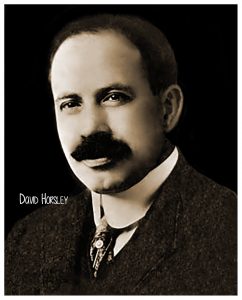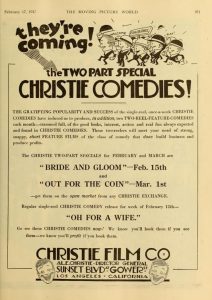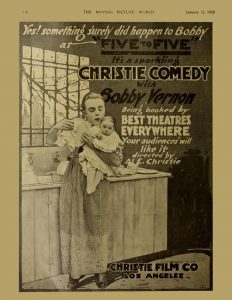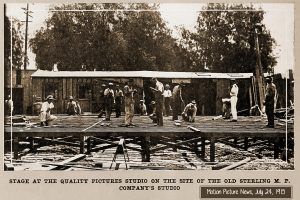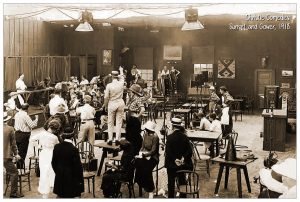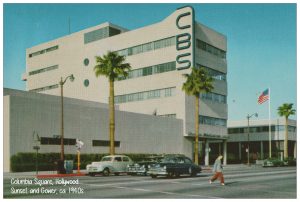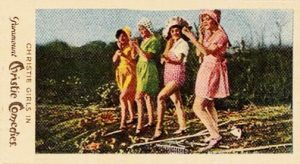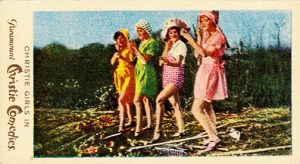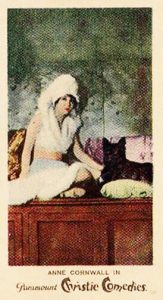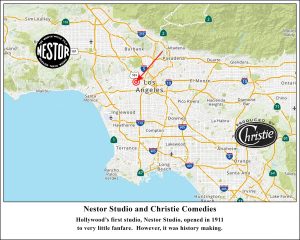Hollywood's First Studio
Nestor Studio and Christie Comedies
6101 Sunset Blvd. (Sunset and Gower)
Click to enlarge
Related Pages:
- Hollywood page
- David Horsley
- Centaur Film Co.
- Bostock
- Nestor Ranch
- Christie at 1040 N. Las Palmas
- Fred Balshofer
- Al Christie
- CBS main page

Nestor StudioChristie Comedies
6101Sunset Blvd.
Site Active 1911-2007
Active as movie studio 1911-1937
Nestor and Christie active 1911-14
David Horsely was not the first movie maker to travel west to shoot in the sunny climes of Southern California, nor was he the first to shoot film in Hollywood. He was not even the first to build a studio in the L.A. area. But he was the first to build a Hollywood studio.
When Horsley stepped off the train on October 27, 1911 he set wheels in motion that continue to this day. Movie maker after movie maker followed Horsley to Hollywood building their own studios. That simple act started an explosion that rippled out into an industry and a brand that lives in a giant way.
David Horsley was the man who invented Hollywood.
Horsley was the original independent producer. His Centaur Film Co. was the first to buck the system. He not only made movies but built and sold bootlegged movies making equipment supplying producers who didn't want to pay the high price of licensing Thomas Edison's patented systems.
To avoid the clutches of Edison's "detectives" (read: thugs), Horsley decided to move his movie making activities to southern California, following the lead of others.
Blondeau's Tavern
Horsley's stature in the movie industry was already well established. He opened the nation's second studio, Centaur Studio, (Bayonne, NJ). As a studio owner and movie maker he was only preceded only by Thomas Edison and his Black Maria studio in East Orange, NJ. Horsley was being harassed by Edison's detectives for alegedly violating Edison's movie equipment patents. Horelsy was building and selling movie equipment based on the French Pathe system. Nevertheless Edison wanted a cut of the profits.
Horsley uprooted his Centaur Film Co. and, along with employee Al Christie, boarded a train for the West Coast to seek brighter skies out of the reach of Edison.
A man Horsley and Christie met on the train suggested he look into Blondeau's Tavern, which was closed and abandoned because Hollywood had voted to become a dry town. Horsley leased it, the land, and several buildings for $30/ month. Quite a bargain.
Horsley, and his partner/brother, William named his new studios Nestor Studios and started a new company, Nestor Comedies. Al Christie, with his brother partner/brother, Charles, started their own company, Christie Comedies, which survived into the 1930s. The Christie brothers managed the fledgling Nestor Studios for the Horsleys.
Horsley and Christie first used the tavern and its grounds to make their first movies, but quickly knocked it down and built a proper studio with shooting stages and a small outdoor shooting area. The studio first ran 180' along a dusty path known as Sunset and about half way up Gower St., roughly 140', toward the now defunct Salem Place.
Nestor merges with with Laemmle's IMP
They form Universal Pictures (yes, that Universal)
On May 20, 1912 Horsley merged his Nestor Studio and Centaur Company, along with several other small companies, with Carl Laemmle's IMP (Independent Movie Production) and the combined company was renamed Universal Pictures. Laemmle, a diminutive, jovial man, reigned as the benevolent dictator at Universal for two decades. Universal first set up shop in partner Mark Dintenfass' Champion Studios in Fort Lee. They also took over the properties of all the other partners and combined them all into two large, new studios: Universal Pictures in Fort Lee, and Universal City in the San Fernando Valley. The merger not only included the Nestor lot, but Nestor Ranch, a large tract of land in Burbank that was later bought by Lasky Feature Play Co., and eventually became Forest Lawn Cemetery. Horsley went to work for Universal and in 1915, after leaving Universal, set up another film company, Bostock Jungle Film Co.
Al Christie stays on
Al Christie stayed on, running the Sunset studio for Universal and producing Christie Comedies there. The lot was still under the ownership of Universal but was soon to be sold off.
The Balshofer Era: Sterling Film Co. & Quality Pictures Corp.
In June of 1914, the lot was bought by movie pioneer Fred Balshofer and comic Ford Sterling and renamed Sterling Pictures. Balshofer's place in the business was well established. He was one of the original partners of the New York Motion Picture Company, and he moved their Bison 101 filming unit to Edendale in 1909 shortly after William Selig built California's first studio up the block. NYMPC was one of the companies absorbed by Universal, and Balshofer went on to a long career in the movies.
Initially, Balshofer brought with him keystone veteran producer and director (the legendary) Henry Lehrman. Lehrman's place in film history was cemented from his nickname "Mr. Suicide." He would frequently ask his actors to put themselves into dangerous and often life-threatening stunts. Lehrman was the creative force behind Sterling Film Co. but left after only a few months after creative disagreements with Balshofer. He went on to a long and storied career.
Ford Sterling was the star at the little studio. He was one of Mack Sennett's comic actors and one of the original Keystone Cops and easily recognizable in his many films. By the time he partnered with Fred Balshofer, his career was established, and he would go on to fame and fortune as an actor. However, he was irresponsible and unreliable as an employee and partner. He would disappear for days at a time, was chronically late, and spent money until he was flat broke and needed help.
Balshofer got fed up and split from Ford and formed Quality Pictures Corp. 1915 in the same spot, re-branding the studio. It was a partnership that included Richard Roland, founder and president of Metro Pictures, and Joseph Engel, producer and Metro co-founder.
Battles with another uncooperative and unreliable star, Francis X. Bushman, cost Balshofer more money than he could handle, and he fired Bushman (who was then hired by his Metro partners and went on to an illustrious career).

The Christie Brothers make a return run
Christie active 1916-1929
Amalgamated active 1929-1937
In 1916 a frustrated Fred Balshofer sold the studio (and built another across the street), to Al and Charles Christie. Al Christie has been working for Universal across the street at the lot later occupied by L-KO and Century. After buying this lot the Christie Brothers promptly doubled its size expanding from Gower Street westward to its new border at El Centro Street where they built new, larger stages including a lit indoor stage, and a backlot area where they shot outdoor scenes.
In the years between about 1916 and 1925 they tore down what remained of the original lot and build new offices and stages. Around 1925 they bought (or bought into) Metropolitan Studios at 1041 N. Las Palmas operating both locations. Al and Charles Christie had reached official mogul status and between 1916 and 1933 Christie Film Company turned out nearly 600 movies.
The stock market crash of 1929 brought hard times to the company. Production slowed tremendously and both studio properties went into receivership. The company produced only a handful of films after that and managed to survive until 1937.
Amalgamated era
This lot was taken over by Amalgamated Studios (ownership unknown). Not much history exists for Amalgamated aside from some photos. Amalgamated operated as a rental studio.

Columbia Square
Active 1938-2007
In 1937 Amalgamated was razed to make room for the new CBS West Coast headquarters.
William Paley, chariman of CBS bought a little radio station, KNX from a man who ran it out of his bedroom. Paley want to make it the flagship of his ambitious expansion to the West Coast. CBS Columbia Square was dedicated on April 30, 1938. The network moved its West Coast flag ship radio station, KNX, to to the new complex. KNXT, one of L.A.'s first television stations, shared the studio and still later the company bought competitor KHJ and moved the television station into the studio. Early in its life CBS expanded the lot again by buying the entire block from Sunset to Salem and later bought the houses on the next block north doubling its size again. The lot now covered two city blocks, from Sunset to Selma, from Gower to El Centro.
By the early 1950s CBS West Coast built a new facility, Television City and move some of its stuio production operations there In the early 1960s it bought the old Republic Studios in Studio City and move the West Coast Headquarters there, where it greatly expanded its television production capabilities. On April 21, 2007 KNX broadcast the final show from the old HQ and CBS move it along with KCBS and KCAL and the entire production department to CBS Studio Center in Studio City and Columbia Square gave way to condos, offices, and retail.




